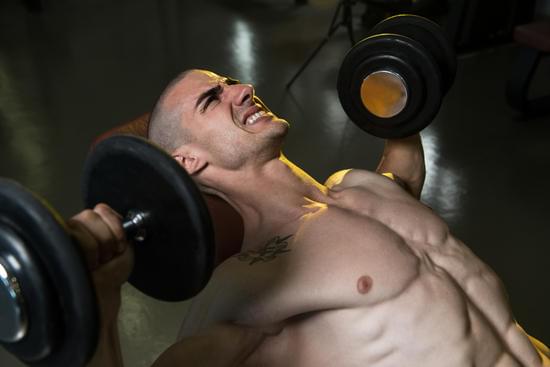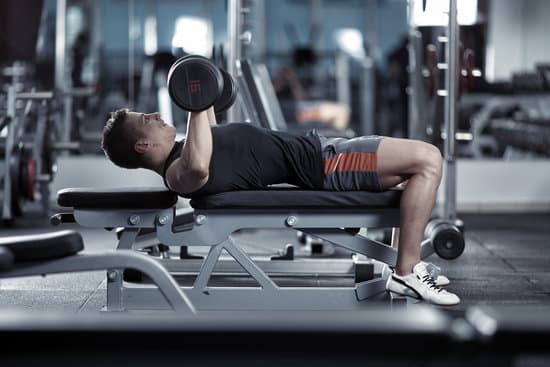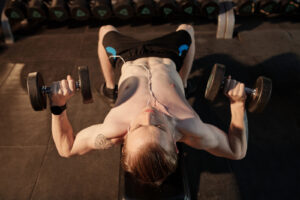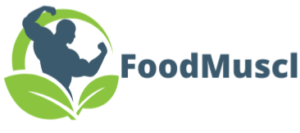Chest Muscle Dumbbell Exercises
Dumbbells provide a full range of motion, activating the chest muscles more effectively than machines or barbells. Chest Muscle Dumbbell Exercises target all areas of the chest, and below are the best exercises for each part of the chest.
1. Upper Chest Dumbbell Exercises

The Incline Dumbbell Press, Incline Dumbbell Fly, and Reverse-Grip Dumbbell Press are three effective exercises for upper chest development and shoulder stability. The Incline Dumbbell Press involves pressing dumbbells upward on a 30-45 degree incline bench while keeping the elbows slightly bent, emphasizing upper chest activation. The Incline Dumbbell Fly focuses on isolating and stretching the upper chest by lowering dumbbells outward in a wide arc with a slight bend in the elbows. The Reverse-Grip Dumbbell Press, a variation of the incline press where the palms face inward, engages more of the upper chest and front deltoids, enhancing muscle activation and variation in training.
2. Middle Chest Dumbbell Exercises

The Flat Dumbbell Press, performed on a flat bench by pressing dumbbells upward and lowering them to chest level, builds overall chest strength and mass; the Dumbbell Floor Press, done on the floor by pressing the dumbbells up and lowering them until elbows touch the ground, reduces shoulder strain while strengthening the chest; and the Dumbbell Fly, either on a flat bench or the floor, involves a wide arc motion to stretch and contract the chest, helping to improve muscle flexibility and development, while avoiding overstretching to prevent injury.
3. Lower Chest Dumbbell Exercises
1. Decline Dumbbell Press
Lie on a decline bench and press dumbbells upward, focusing on targeting the lower portion of the chest to effectively develop and strengthen this area.

2. Decline Dumbbell Fly
The decline fly, similar to the flat fly but performed on a decline bench, targets the lower chest muscles more effectively, enhancing their isolation and definition while also improving overall chest strength and muscle development.

3. Dumbbell Pullover
Lie on a flat surface while holding a dumbbell overhead, then lower it behind your head and bring it back up, targeting the lower chest, lats, and serratus anterior, with a focus on maintaining controlled movement and engaging the muscles for maximum activation and strength development.

Chest Muscle Dumbbell Exercises and Training Methods
A structured workout plan helps in muscle hypertrophy and strength building.
1. Dumbbell Chest Workouts Without a Bench
You can still have an effective chest workout without a bench by incorporating floor-based and standing exercises like the Dumbbell Floor Press for chest and triceps activation without shoulder strain, the Standing Dumbbell Squeeze Press by pressing a dumbbell between both palms, the Dumbbell Pullover on the Floor that targets both the chest and core, and Neutral Grip Push-Ups with Dumbbells to enhance range of motion and improve wrist comfort, all of which can help you build strength and stability in the upper body.
2. Workout Plans for Different Levels
Here’s a combined version of your workout routine with added details: For beginners, the routine involves 3 days a week with 4 sets of 8-12 reps, including exercises like Flat Dumbbell Press, Incline Dumbbell Fly, Dumbbell Floor Press, and Dumbbell Pullover. The intermediate routine requires 4 days a week, with 5 sets of 6-12 reps, incorporating Incline Dumbbell Press, Flat Dumbbell Fly, Decline Dumbbell Press, and Dumbbell Squeeze Press. For advanced trainees, the routine extends to 5 days a week with 5-6 sets of 6-12 reps, utilizing supersets and drop sets: Superset 1 includes Incline Dumbbell Press + Incline Fly, Superset 2 includes Flat Dumbbell Press + Dumbbell Floor Press, and for the Dumbbell Pullover, a drop set technique is used, reducing the weight with each set.
This progressive structure is designed to help increase strength, muscle mass, and endurance by gradually increasing the volume, frequency, and intensity of exercises.
3. Training Tips and Recovery for Chest Development
For optimal muscle growth, strength, and definition, follow these guidelines: To optimize chest growth, incorporate key training principles such as progressive overload (gradually increasing weights or reps), time under tension (slowing down reps for greater muscle activation), full range of motion (ensuring controlled movement from top to bottom), and appropriate rest between sets (60-90 seconds for muscle growth or 30-45 seconds for endurance), which together enhance muscle stimulation, recovery, and overall performance for effective chest development.
Nutrition and recovery are essential for muscle growth, with protein sources like chicken, beef, fish, eggs, and whey protein fueling development, healthy fats such as avocado, nuts, and olive oil supporting overall health, and carbs from brown rice, oats, and sweet potatoes providing energy, while adequate rest, aiming for 7-9 hours of sleep, avoiding overtraining by training muscle groups like the chest 2-3 times per week, and ensuring proper hydration and stretching for recovery and injury prevention, all contribute significantly to achieving optimal muscle growth and performance.
By following this dumbbell chest workout guide, you can effectively build a strong, well-defined chest whether you have a bench or not. Remember to train consistently, use proper form, and fuel your body with the right nutrition.
Read more about how to Back muscle building exercises




